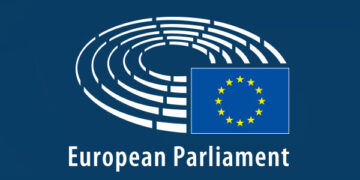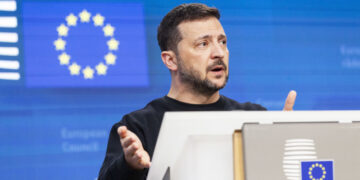Any deal between Donald Trump and Greenland would either result in Greenlanders receiving less than they get from Denmark or the US paying more for what it already has, writes Ulrik Pram Gad.
As a Danish researcher, I have spent almost two decades in academia working on Greenland’s role in Arctic security. Before that, I worked with foreign policy for the Government of Greenland.
From this vantage point, it has been fascinating to follow the frantic attempts to provide intellectual scaffolding for Donald Trump’s idea that he should purchase Greenland. Among these attempts, the campaign by Alexander Gray, former National Security Council Chief of Staff and now CEO of American Global Strategies, is probably the most interesting.
Hardly a deal to be made
Literally buying Greenland is not feasible under the principle of self-determination under international law as promoted by the United States since WWII. Moreover, Greenlanders consistently insist that while “open for business”, they are “not for sale”. In essence, Gray suggests morphing Trump’s impulse to buy Greenland into buying over the Greenlanders by offering them a better deal.
Gray worked in the National Security Council during Trump’s 2019 attempt to buy the island. On the one hand, Gray’s is possibly the least ill-conceived of attempts at making sensible policy out of the idea. On the other hand, precisely because Gray actually studied the matter and knows what he is talking about, his detailed suggestion makes it clear that there is hardly a deal to be made that Trump or Greenland would want.
Greenland already has a Nordic welfare system
Gray understands that Greenland’s future is decided in Nuuk rather than Copenhagen. He has studied Greenland’s current relations with Denmark. So, he wants the Trump administration to offer Greenlanders a more favourable relationship with the United States.
The first trouble for Gray’s project is that what he finds in the established US toolbox for “insular affairs” hardly matches what Greenlanders already have. Gray considers but dismisses a status like Puerto Rico’s, since Greenlanders currently have (contrary to Puerto Rico) both voting representatives in the Danish parliament and an extensive say over foreign and security policies concerning their island. Gray therefore concentrates on the Compacts of Free Association between three states in the Pacific (Palau, Micronesia and the Marshall Islands). These are sovereign states, each with UN membership, a prospect most attractive to Greenland.
There are at least three problems with this plan. First, the citizens of the freely associated states enjoy the right to migrate to the United States and benefit from some health and social services there. Gray wants to offer the same to Greenland. However, Greenlanders today have full Danish citizenship with security, not just freedom of mobility to all of the EU. Crucially, they also have full Nordic-style welfare rights, including a single payer health system, comparatively generous social security and free tuition and scholarships for all levels of education.
Second, the freely associated states in the Pacific receive various subsidies and services from the US. So does Greenland from Denmark, only the sum per capita is roughly six times larger than what the US pays in the Pacific ($12,500 vs $2,025, depending on how you count). Moreover, while substantial parts of the Pacific subsidies are dedicated to specific programmes overseen by a US oversight committee, Danish subsidies to Greenland come as a lump sum with no strings attached. Gray wants Trump to offer double what Denmark currently pays, which is far beyond the financial assistance available under the Compacts of Free Association.
Third, Gray eyes deposits of critical minerals in the Greenlandic subsoil and wants the US to offer to invest in their development. But the Government of Greenland have long welcomed US investments and are currently engaging both the EU and the United States in talks about how to make mining in Greenland attractive. Greenlandic mining regulations are stricter on environment and workforce protection, however what is really limiting investments in Greenlandic mines in particular – and the extraction of critical minerals in general – is Chinese monopolies on the processing of the attractive minerals.
The US already has military sovereignty over Greenland
Finally, the payoff for Gray is the military base rights and security veto that the Compacts of Free Association buy the US in the Pacific. However, here the paradox of transposing the model to Greenland is most apparent. On the one hand, the United States has under a 1951 agreement almost full military sovereignty over Greenland.
This agreement, interminable for Greenland and Denmark, allows the US to run its Pituffik Space Base (originally the Thule Air Base), which is currently surveying the air and space domains for Russian and Chinese missiles and satellites. It is hard to conceive of any other military installation that the agreement would allow Denmark or Greenland to deny the US. Moreover, prompted by the US under both Trump and Biden, Greenlandic and Danish authorities made all Chinese attempts at investment or establishing infrastructure in Greenland evaporate.
On the other hand, an important driver behind Greenland’s self-determination movement has been demands to have insight and a say in relation to the security politics conducted by Denmark and the US involving the island. In Greenland’s recently published draft constitution, the Government of Greenland’s battle cry “Nothing about us without us” was translated into a series of limitations on the kinds of security decisions that can be “sold” in the event of an independent Greenland entering a compact of free association.
Why would Greenland want to sign away its hard-fought influence over security politics? Greenlandic politicians have indeed pursued sovereignty supported by a compact of free association – but consistently preferred that such a compact be with the Danish welfare state rather than the United States. At the same time, the Government of Greenland has consistently responded affirmatively to US security needs, not least as a reaction to Russian aggression in Ukraine and Chinese oppression of indigenous peoples in Tibet and Xinjiang.
Gray’s scheme copies the imperialism of Xi Jinping and Vladimir Putin to turn Trump’s designs on Greenland into something that is compatible with US interests. But why would Trump-the-deal-maker want to pay huge subsidies on a welfare state he does not want for his taxpayers at home to secure mining rights and military control that he already has for free?
Note: This article gives the views of the author, not the position of EUROPP – European Politics and Policy or the London School of Economics. Featured image credit: Vadim_N / Shutterstock.com






































Discussion about this post